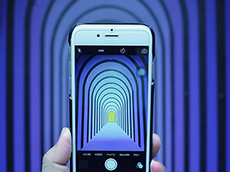【小站课堂】雅思阅读选词摘要题讲解--Visual Symbols and the Blind
- 2016年10月09日11:21 来源:小站教育作者:小站雅思编辑
- 参与(0) 阅读(17219)
小站独家,雅思阅读机经真题解析。一切患有雅思阅读刷题强迫症的烤鸭,请看这里。小站精心整理了一批雅思阅读机经真题。如果你的剑桥雅思阅读已是烂熟于心,那么这一系列的雅思阅读机经真题真的很适合你,搭配上绝对原创的讲解,还有全文的中文翻译,这等阅读大餐,还等什么!
Visual Symbols and the Blind
Part 1
From a number of recent studies, it has become clear that blind people can appreciate the use of outlines and perspectives to describe the arrangement of object and other surfaces in space. But pictures are more than literal representations. This fact was drawn to my attention dramatically when a blind woman in one of my
investigations decided on her own initiative to draw a wheel as it was spinning. To show this motion, she traced a curve inside the circle (Fig. 1). I was taken aback. Lines of motion, such as the one she used, are a very recent invention in the history of illustration. Indeed, as art scholar David Kunzle notes, Wilhelm Busch, a trend-setting nineteenth-century cartoonist, used virtually no motion lines in his popular figures until about 1877.
When I asked several other blind study subjects to draw a spinning wheel, one particularly clever rendition appeared repeatedly: several subjects showed the wheel’s spokes as curved lines. When asked about these curves, they all described them as metaphorical ways of suggesting motion. Majority rule would argue that this device somehow indicated motion very well. But was it a better indicator than, say, broken or wavy lines – or any other kind of line, for that matter? The answer was not clear. So I decided to test whether various lines of motion were apt ways of showing movement or if they were merely idiosyncratic marks. Moreover, I wanted to discover whether there were differences in how the blind and the sighted interpreted lines of motion.
To search out these answers, I created raised-line drawings of five different wheels, depicting spokes with lines that curved, bent, waved, dashed and extended beyond the perimeter of the wheel. I then asked eighteen blind volunteers to feel the wheels and assign one of the following motions to each wheel: wobbling, spinning fast, spinning steadily, jerking or braking. My control group consisted of eighteen sighted undergraduates from the University of Toronto.
All but one of the blind subjects assigned distinctive motions to each wheel. Most guessed that the curved spokes indicated that the wheel was spinning steadily; the wavy spokes, they thought, suggested that the wheel was wobbling; and the bent spokes were taken as a sign that the wheel was jerking. Subjects assumed that spokes extending beyond the wheel’s perimeter signified that the wheel had its brakes on and that dashed spokes indicated the wheel was spinning quickly. In addition, the favored description for the sighted was the favored description for the blind in every instance. What is more, the consensus among the sighted was barely higher than that among the blind. Because motion devices are unfamiliar to the blind, the task I gave them involved some problem solving. Evidently, however, the
blind not only figured out meanings for each line of motion, but as a group they generally came up with the same meaning at least as frequently as did sighted subjects.
Part 2
We have found that the blind understand other kinds of visual metaphors as well. One blind woman drew a picture of a child inside a heart – choosing that symbol, she said, to show that love surrounded the child. With Chang Hong Liu, a doctoral student from China, I have begun exploring how well blind people understand the symbolism behind shapes such as hearts that do not directly represent their meaning. We gave a list of twenty pairs of words to sighted subjects and asked them to pick from each pair the term that best related to a circle and the term that best related to a square.
For example, we asked: What goes with soft? A circle or a square? Which shape goes with hard?
All our subjects deemed the circle soft and the square hard. A full 94% ascribed happy to the circle, instead of sad. But other pairs revealed less agreement: 79%matched fast to slow and weak to strong, respectively. And only 51% linked deep to circle and shallow to square. (See Fig. 2) When we tested four totally blind volunteers using the same list, we found that their choices closely resembled those made by the sighted subjects. One man, who had been blind since birth, scored extremely well.
He made only one match differing from the consensus, assigning ‘far’ to square and ‘near’ to circle. In fact, only a small majority of sighted subjects – 53% – had paired far and near to the opposite partners. Thus, we concluded that the blind interpret abstract shapes as sighted people do.
Questions 33–39
Complete the summary below using words from the box.
Write your answers in boxes 33–39 on your answer sheet.
NB You may use any word more than once.
In the experiment described in Part 2, a set of word 33_____________ was used to investigate whether blind and sighted people perceived the symbolism in abstract 34__________ in the same way. Subjects were asked which word fitted best with a circle and which with a square. From the 35______________ volunteers, everyone thought a circle fitted ‘soft’ while a square fitted ‘hard’. However, only 51% of the 36____________ volunteers assigned a circle to 37_____________. When the test was later repeated with 38_____________ volunteers, it was found that they made 39_____________ choices.
associations blind deep hard hundred identical pairs shapes
sighted similar shallow soft words
讲解:
长难句练习:
1. All but one of the blind subjects assigned distinctive motions to each wheel.
参考译文:除了一个人,其他所有的盲人都将具体的动作与车轮搭配了起来。
知识点:all but的用法
1) 除了—都
2) 几乎、差不多
3) 几乎完全的
2. Evidently, however, the blind not only figured out meanings for each line of motion, but as a group they generally came up with the same meaning at least as frequently as did sighted subjects.
参考译文:然而,很明显,盲人不仅能够搞清楚每种运动线所代表的意义,而且作为一个团队,他们达成共识的频率也不必普通人低。
知识点:come up with the same meaning可以等同于have consensus on sth
3. In fact, only a small majority of sighted subjects---53受试者%---had paired far and near to the opposite partners.
参考译文:实际上,也只是刚刚过半---53%---普遍认为圆形代表远,而方形代表近。
知识点:opposite partners在这里可以理解为相反的选择。



































